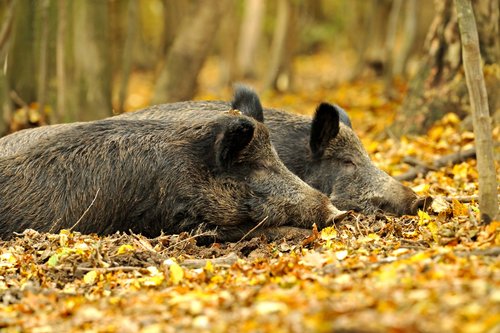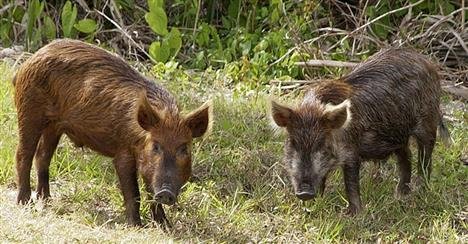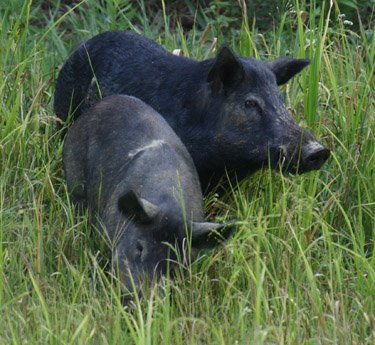Hog Hunting Ammunition – The Ultimate Guide for Success 2024
When it comes to hog hunting, selecting the right ammunition is of utmost importance. These tough, resilient creatures require specific types of ammo that can effectively stop them in their tracks. Whether you are a seasoned hunter or a novice in the field, understanding the ins and outs of hog hunting ammunition is essential for a successful and ethical hunt.
Importance of selecting the right ammunition for hog hunting
Hogs possess strong muscles, dense bodies, and thick hides, making them quite challenging to take down. This is where choosing the best ammo for hogs becomes crucial.
Using inadequate ammunition may result in wounded hogs escaping into dense cover or suffering unnecessarily. The right hog-hunting ammunition ensures humane kills by delivering enough energy to penetrate their tough exterior and reach vital organs reliably.
It maximizes stopping power while minimizing unnecessary damage to meat. Moreover, proper bullet selection can also help prevent over-penetration, reducing the risk of injury to nearby objects or other animals.
Factors to consider when choosing hog hunting ammunition
Selecting ammo for hog hunting involves considering factors directly impacting shot placement and terminal performance. One crucial factor is caliber selection, as different calibers offer varying levels of energy transfer and penetration capabilities. Bullet construction is another important consideration.
For instance, expanding bullets designed specifically for hunting ensures controlled expansion upon impact within the animal’s body cavity. This promotes energy transfer and creates an effective wound channel that increases your chances of a quick and clean kill.
Ammunition quality should not be overlooked either since consistency in powder charge and bullet performance will ultimately affect accuracy at different ranges. Factors such as bullet weight, velocity, ballistic coefficient (BC), recoil management, and personal shooting preferences also come into play when selecting the most suitable hog-hunting ammunition.

Hog Anatomy and Behavior
Overview of Hog Anatomy and Vital Organs
When it comes to hog hunting, it’s crucial to have a solid understanding of these formidable creatures’ anatomy and vital organs. Knowing where to aim can distinguish between a clean, ethical kill and a wounded animal that may suffer unnecessarily. Hogs are robust animals with thick hides, muscular bodies, and a layer of fat that provides insulation.
Their vital organs are protected by tough muscle and bone layers, making shot placement critical for effective takedowns. Hogs’ most reliable shot placements are in the heart-lung area or the brain.
Aiming slightly behind the shoulder is recommended for heart-lung shots to maximize your chances of success. This ensures you hit both lungs and possibly the heart, leading to rapid blood loss and swift incapacitation.
On the other hand, aiming for the brain requires precise marksmanship as it is a smaller target located between the eyes, just above where the snout meets the forehead. A well-placed brain shot results in instant cessation of all motor functions.
Insight into Hog Behavior and Movement Patterns
Understanding hog behavior and movement patterns can greatly assist in successful hunts. Hogs are nocturnal creatures by nature; they prefer to feed during dusk or late at night when they feel more secure under cover of darkness.
However, they can also be active during early morning hours or even throughout the day if pressured or searching for food. These omnivorous animals possess an exceptional sense of smell, which they rely on heavily when feeding or detecting potential threats nearby.
They often use their snouts to search for edible vegetation or insects beneath leaves and soil. Hogs have adapted well to different environments, including forests, swamps, fields, and suburban areas near human settlements.
They are known to be intelligent and highly adaptable, sometimes making their movement patterns unpredictable. Hogs may exhibit solitary behavior or travel in groups called sounders, consisting of sows (females) and their offspring.
When hunting hogs, it’s essential to consider wind direction to avoid being detected by their keen sense of smell. Knowing the terrain and likely feeding areas can help you strategically position yourself for a successful hunt.
.308 Winchester: Ideal for medium to large hogs
Regarding hog hunting, the .308 Winchester is a popular choice among seasoned hunters. Known for its exceptional accuracy and stopping power, this caliber is perfectly suited for taking down medium to large-sized hogs.
The ballistic characteristics of the .308 Winchester make it a reliable and effective option in various hunting scenarios. Its moderate recoil allows quick follow-up shots, ensuring you have the best chance at bagging your target.
Selecting the right bullet type and weight is crucial to maximize this caliber’s potential. For hog hunting, it is recommended to choose bullets with controlled expansion, such as those designed for big game hunting.
These bullets penetrate deeply while expanding reliably upon impact, inflicting significant damage to vital organs and ensuring a clean kill. Bullet weights ranging from 150 to 180 grains are most commonly used with the .308 Winchester, offering an ideal balance between velocity and terminal performance.
.30-06 Springfield: Versatile option for hog sizes
If you seek versatility in hog hunting ammunition, look no further than the .30-06 Springfield cartridge. Generations of hunters have relied upon this time-tested caliber due to its wide-ranging capabilities when targeting hogs of different sizes.
The .30-06 Springfield offers excellent long-range accuracy and ample stopping power. The effective range of this caliber extends beyond 300 yards, making it suitable for open-field hunting or when distance shots are necessary.
With bullet options ranging from lighter varmint rounds to heavier controlled expansion projectiles designed specifically for big game like hogs, hunters can tailor their ammunition selection based on their preferred shooting scenario and target size. One advantage of the .30-06 Springfield is its impressive penetration capabilities, ensuring deep and reliable wound channels.
This characteristic is particularly valuable when hogs are heavily muscled or shooting through dense brush. By choosing the appropriate bullet weight and design, hunters can confidently dispatch hogs with precision while minimizing the risk of over-penetration.
.300 Winchester Magnum: High-powered choice
For those seeking a high-powered option to tackle big boars or engage in long-range hunting scenarios, the .300 Winchester Magnum is a formidable choice. Favored by hunters who demand exceptional energy transfer and superior performance at extended distances, this cartridge delivers impressive stopping power.
The .300 Winchester Magnum boasts velocities that allow for reliable expansion even at extended ranges, ensuring optimal terminal performance on impact. When considering bullet selection for hog hunting with this caliber, it is essential to prioritize accuracy and shot placement.
Choosing bullets capable of retaining their weight after expansion will increase the chances of penetrating deeply into vital organs and effectively bringing down larger hogs. While the recoil of the .300 Winchester Magnum might be more substantial compared to other calibers, its advantages in long-range shooting situations make it worth considering for experienced hunters seeking to take down big boars or engage targets at extreme distances.
Specialized Ammunition Types for Hog Hunting
Frangible Bullets: Reducing the risk of over-penetration
When it comes to hog hunting, one of the key considerations is the potential for over-penetration. This refers to a bullet passing through and potentially injuring unintended targets beyond the hog. Frangible bullets are designed specifically to minimize this risk.
These unique projectiles are made from compressed powdered metal or other materials that break apart upon impact, reducing their ability to travel through barriers. One of the primary benefits of frangible bullets in hog hunting is their ability to transfer energy more effectively upon impact.
When a brittle bullet hits its target, it rapidly disintegrates, creating a wide dispersal pattern that increases the chances of hitting vital organs. This improves stopping power and humane kills while reducing the risk of stray projectiles harming bystanders or livestock nearby.
Suitable calibers and bullet designs
Frangible bullets come in various calibers suitable for hog hunting. Common calibers include .223 Remington, .243 Winchester, and 7.62x39mm.
Matching your chosen caliber with an appropriate bullet design that maximizes frangibility without sacrificing performance is essential. Hollow-point frangible bullets are popular due to their controlled expansion upon impact and rapid fragmentation.
When selecting ammo for hog hunting using frangible bullets, consider factors like bullet weight, velocity, and shot placement accuracy. Choosing a caliber that offers sufficient power for effective takedown while ensuring safe shooting distances within your environment is crucial.
Shotgun Slugs: Effective close-range option
For hunters who prefer closer encounters with hogs or those who navigate dense brush areas where longer-range shots may be limited, shotgun slugs can be an effective choice. Unlike traditional shotgun pellets used in bird hunting, slugs are solid projectiles with enhanced accuracy and penetration.
Various shotgun slugs are used in hog hunting, including foster slugs, sabot slugs, and Brenneke slugs. Foster slugs feature a hollow base that promotes aerodynamic stabilization during flight.
Sabot slugs use a plastic sabot to improve accuracy by reducing friction with the barrel. Brenneke slugs are renowned for their deep penetration and ability to maintain momentum even after striking dense muscle mass.
Accuracy, range, and recommended shot placement.
When using shotgun slugs for hog hunting, it’s crucial to consider their effective range. Shotgun slug ammunition is typically effective at ranges up to 75 yards or slightly more, depending on the firearm and shooter’s skill level. Accuracy is paramount when using slugs since they lack the spread of shot pellets.
Aim for vital areas such as the heart or lungs when taking your shot for optimal results. This requires careful shot placement to ensure ethical kills.
Understanding hog anatomy can help determine where to aim precisely. Remember that a broadside or quartering-away shot offers better target areas than facing shots that may involve tough shoulder bones.
Specialized ammunition types for hog hunting offer tailored solutions to enhance performance and safety in the field. Frangible bullets reduce over-penetration risks while providing improved stopping power with controlled fragmentation upon impact.
Shotgun slugs excel at close-range encounters and demand precision, aiming for effective takedowns on hogs. By selecting the appropriate ammunition type based on your specific needs and environment, you can optimize your hog hunting experience while prioritizing ethical hunts and minimizing risks.
Special Considerations for Nighttime Hog Hunting
Night Vision Compatible Ammo Options
When it comes to nighttime hog hunting, having the right ammunition is crucial. One option to consider is using night vision-compatible ammo. When fired, these specially designed rounds are equipped with tracer compounds that emit a visible light trail.
This enables hunters to use night vision optics to track the projectile’s trajectory and make precise shots in low-light conditions. However, it’s important to note that while tracer rounds can be useful for visibility, they have certain limitations.
Tracer ammunition tends to be less accurate than traditional rounds due to variations in velocity caused by the tracer compound’s weight distribution. Additionally, some states have restrictions on tracer rounds for hunting, so it’s essential to check local regulations before selecting this type of ammo.
Recommended Calibers with Night Vision Optics
Pairing night vision optics with the right caliber is essential for successful nighttime hog hunting. While various calibers can be effective, some are well-suited for low-light conditions.
One recommended caliber is the .308 Winchester, known for its versatility and performance at medium ranges. The .308 Winchester offers a good balance between stopping power and manageable recoil, making it popular among hog hunters who utilize night vision optics.
Another suitable option is the .30-06 Springfield, which provides excellent penetration and accuracy even in dimly lit environments. These calibers work well with night vision optics because their bullet weights and ballistics provide sufficient energy transfer on target while minimizing bullet drop in low-light scenarios.
Subsonic Ammo: Stealthy Approach to Minimize Noise
Understanding Subsonic Ammo
Subsonic ammunition presents an intriguing solution for hog hunters seeking a stealthy approach and reduced noise signature during their nocturnal pursuits. Subsonic rounds are specifically engineered to travel below the speed of sound, resulting in a quieter gunshot than supersonic ammunition. This is achieved by using heavier projectiles and reducing powder charges, which lowers the overall velocity of the bullet.
The reduced velocity also contributes minimal recoil, allowing for faster follow-up shots and increased accuracy. However, it’s important to note that due to their decreased speed and energy, subsonic rounds may have limited effective range and terminal performance compared to their supersonic counterparts.
Best Ammo for Hogs: Selecting Ammo for Hog Hunting
Several factors must be considered when choosing the best ammo for hog hunting. Understanding hog anatomy and behavior is crucial in selecting appropriate ammunition for effective shot placement. Additionally, considering specific hunting conditions, such as nighttime operations, is essential.
Night vision-compatible ammo provides visibility, while subsonic rounds offer a silent approach. For nighttime hog hunting with night vision optics, calibers like .308 Winchester and .30-06 Springfield are recommended due to their ballistics and performance in low-light scenarios.
Selecting the right ammunition for hog hunting is vital for success in the field. Whether embarking on nighttime hunts or opting for a stealthy approach with subsonic ammo, understanding the benefits and limitations of different options allows hunters to make informed decisions based on their specific needs.
By considering factors such as night vision compatibility or reduced noise signature, hunters can enhance their chances of achieving precise shots on hogs while minimizing disturbance in nocturnal environments. Remember – investing time into choosing appropriate hog hunting ammunition ensures an ethical hunt and enhances overall hunting experiences.






